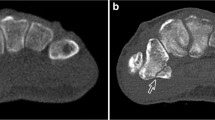Abstract
Objective
To compare the diagnostic accuracy and radiation exposure of cone beam computed tomography (CBCT) and multislice computed tomography (MSCT) in the evaluation of finger fractures.
Materials and methods
In a 3-year period, 57 consecutive patients with post-traumatic fractures of the metacarpal–phalangeal (MCP), proximal interphalangeal (PIP) and distal interphalangeal (DIP) joints with involvement of the articular surface were studied by means of CBCT and MSCT. Student’s t test was used to compare CBCT and MSCT accuracy in evaluating the percentage of joint surface involvement and in detecting bone fragments. The average tissue-absorbed doses of CBCT and MSCT were also compared. A value of p < 0.05 was considered statistically significant. Inter-observer agreement was calculated.
Results
In all cases, CBCT allowed the percentage of articular involvement to be correctly depicted compared with MSCT, showing 100% sensitivity and specificity (p < 0.001). A total of 103 bone fragments were depicted on MSCT (mean 3.8 per patient, range 1–23). CBCT indicated 92 out of 103 fragments (89.3%) compared with MSCT (mean diameter of missed fragments 0.9 mm, range 0.6–1.3 mm), with no statistically significant difference between CBCT and MSCT (p < 0.025). Multislice CT radiation exposure was significantly higher than that of CBCT (0.18 mSv vs 0.06 mSv, p < 0.0025). Inter-observer agreement was good (overall κ = 0.89–0.96).
Conclusions
Cone beam CT may be considered a valuable imaging tool in the preoperative assessment of finger fractures, when MSCT is not available.




Similar content being viewed by others
References
Badia A, Riano F, Ravikoff J, Khouri R, Gonzalez-Hernandez E, Orbay JL. Dynamic intradigital external fixation for proximal interphalangeal joint fracture dislocations. J Hand Surg. 2005;30:154–60.
Chinchalkar SJ, Gan BS. Management of proximal interphalangeal joint fractures and dislocations. J Hand Ther. 2003;16:117–28.
Lubahn JD, Hood JM. Fractures of the distal interphalangeal joint. Clin Orthop Relat Res. 1996;(327):12–20.
Glickel SZ, Barron OA. Proximal interphalangeal joint fracture dislocations. Hand Clin. 2000;16:333–44.
Heuck A, Bonél H, Stäbler A, Schmitt R. Imaging in sports medicine: hand and wrist. Eur J Radiol. 1997;26:2–15.
Schenck RR. Dynamic traction and early passive movement for fractures for the proximal interphalangeal joint. J Hand Surg. 1986;11:850–8.
Newington DP, Davis TR, Barton NJ. The treatment of dorsal fracture-dislocation of the proximal interphalangeal joint by closed reduction and Kirschner wire fixation: a 16-year follow up. J Hand Surg. 2001;26:537–40.
Viegas SF. Extension block pinning for proximal interphalangeal joint fracture dislocations: preliminary report of a new technique. J Hand Surg. 1992;17:896–901.
Grant I, Berger AC, Tham SK. Internal fixation of unstable fracture dislocations of the proximal interphalangeal joint. J Hand Surg. 2005;30:492–8.
Zeitoun F, Dubert T, Frot B, Laredo JD. Imaging of the wrist and of the hand: what is the best modality? J Radiol. 2001;82:335–52.
Schreibman KL, Freeland A, Gilula LA, Yin Y. Imaging of the hand and wrist. Orthop Clin North Am. 1997;28:537–82.
Feldkamp LA, Davis LC, Webb S. Comments, with reply, on: Tomographic reconstruction from experimentally obtained cone-beam projections’ by S. Webb, et al. IEEE Trans Med Imaging. 1988;7(1):73–4.
Guerrero ME, Reinhilde J, Loubele M, Schutyser F, Suetens P, Van Steenberghe D. State-of-the-art on cone beam CT imaging for preoperative planning of implant placement. Clin Oral Invest. 2006;10:1–7.
Mozzo P, Procacci C, Tacconi A, et al. A new volumetric CT machine for dental imaging based on the cone-beam technique: preliminary results. Eur Radiol. 1998;8:1558–64.
Faccioli N, Barillari M, Guariglia S, et al. Radiation dose saving through the use of cone-beam CT in hearing-impaired patients. Radiol Med. 2009;114:1308–18.
Guerrero ME, Jacobs R, Loubele M, Schutyser F, Suetens P, van Steenberghe D. State-of-the-art on cone beam CT imaging for preoperative planning of implant placement. Clin Oral Invest. 2006;10:1–7.
Tsiklakis K, Donta C, Gavala S, et al. Dose reduction in maxillofacial imaging using low dose Cone Beam CT. Eur J Radiol. 2005;56:413–7.
Ludlow JB, Davies-Ludlow LE, Brooks SL, et al. Dosimetry of 3 CBCT devices for oral and maxillofacial radiology: CB Mercuray, NewTom 3G and i-CAT. Dentomaxillofac Radiol. 2006;35:219–26.
Osorio F, Perilla M, Doyle DJ, Palomo JM. Cone beam computed tomography: an innovative tool for airway assessment. Anesth Analg. 2008;106:1803–7.
Hiwatashi A, Yoshiura T, Noguchi T, et al. Usefulness of cone-beam CT before and after percutaneous vertebroplasty. AJR Am J Roentgenol. 2008;191:1401–5.
Dalchow CV, Weber AL, Yanagihara N, et al. Digital volume tomography: radiologic examinations of the temporal bone. AJR Am J Roentgenol. 2006;186:416–23.
Dalchow CV, Weber AL, Bien S, et al. Value of digital volume tomography in patients with conductive hearing loss. Eur Arch Otorhinolaryngol. 2006;263:92–9.
Cerini R, Faccioli N, Barillari M, et al. Bionic ear imaging. Radiol Med. 2008;113:265–77.
Schenck RR. Classification of fractures and dislocations of the proximal interphalangeal joint. Hand Clin. 1994;10:179–85.
Capo JT, Hastings II H, Choung E, Kinchelow T, Rossy W, Steinberg B. Hemicondylar hamate replacement arthroplasty for proximal interphalangeal joint fracture dislocations: an assessment of graft suitability. J Hand Surg. 2008;33:733–9.
Miracle AC, Mukherji SK. Conebeam CT of the head and neck. I. Physical principles. AJNR Am J Neuroradiol. 2009;30:1088–95.
Robinson S, Suomalainen A, Kortesniemi M. MU CT. Eur J Radiol. 2005;56:185–91.
Author information
Authors and Affiliations
Corresponding author
Rights and permissions
About this article
Cite this article
Faccioli, N., Foti, G., Barillari, M. et al. Finger fractures imaging: accuracy of cone-beam computed tomography and multislice computed tomography. Skeletal Radiol 39, 1087–1095 (2010). https://doi.org/10.1007/s00256-010-0911-7
Received:
Revised:
Accepted:
Published:
Issue Date:
DOI: https://doi.org/10.1007/s00256-010-0911-7




